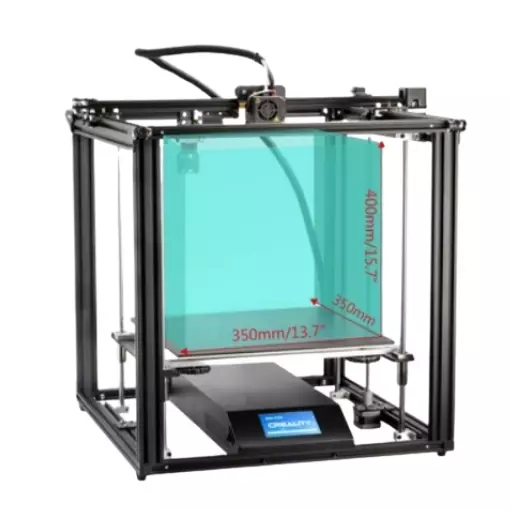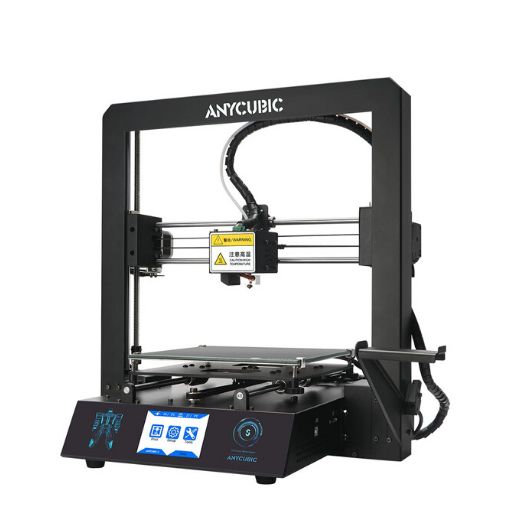Compare Ender 5 Plus vs Mega S
Comparison between the best 3D printers
Choose the best 3D printer at the best price. The cheapest 3D printers are here.
Buy a 3D printer here with 3D Fila.
 |
 |
|
| Model | Ender 5 Plus[BUY Ender 5 Plus] |
Mega S |
| Printing Material | Filament | Filament |
| Buy Filament for Creality 3D Ender 5 Plus | Buy Filament forAnycubic Mega S | |
| Estimated price | $599,00 | $149,00 |
| Manufacturer | Creality 3D | Anycubic |
| Release Year | 2019 | 2019 |
| Print Volume [mm] | 350x350x400 | 210x210x205 |
| Printer Size [mm] | 632x619x666 | 405x410x452 |
| Weight [kg] | 18,2 | 14,5 |
| Power Loss Recovery | YES | YES |
| Enclosed printer | NO | NO |
| Bed Leveling | Automatic | Manual |
| Filament End Sensor | YES | YES |
| Bed type | Heated | Heated |
| Power supply system | Bowden | Bowden |
| Standard nozzle | 0,4 | 0,4 |
| Maximum Nozzle Temperature [°C] | 260 | 260 |
| Maximum Bed Temperature [°C] | 100 | 110 |
| Maximum printing speed [mm/s] | 180 | 100 |
| Filament holder | YES | YES |
| Camera for supervision | NO | NO |
| Recommended filaments | PLA, TPU, ABS, PETG | PLA, TPU, ABS, PETG |
| Recommended slicers | Cura, Simplify, Slic3r | Cura, Simplify, Slic3r |
| Maximum Resolution [mm] | 0,1 | 0,1 |
| Processor | 32 bits | 8 bits |
| Display | Touchscreen TFT 4,3'' | Touchscreen TFT 2,8'' |
| Power Supply | 24V / 504W | 12V / 300W |
| Connectivity | SD / USB | SD / USB |
| Operating systems | Windows, Mac, Linux | Windows, Mac, Linux |
| Date of registration in the system | 2021-04-14 | 2021-04-15 |
| Release date | 2019 | 2019 |
| Extra features | The Ender 5 Plus offers a large print volume (350x350x400 mm) and fast assembly. It includes a BLTouch sensor, but with range limitations. It stands out for its dimensional accuracy, although it requires adjustments to the slicer settings. Despite the noise, its integrated design saves space, and includes features such as a filament sensor and power resumption. Ideal for large projects, it requires refinement in the settings for high-quality prints. | The Anycubic Mega S offers a printing platform with excellent adhesion, easy removal after cooling. It has a filament sensor for a better experience with flexible materials and a multilingual and intuitive color touchscreen. Assembly is quick, requiring only 8 screws and 3 connections. It has a large build volume (210 x 210 x 205 mm), high positioning accuracy and supports a variety of materials, including TPU, PLA, ABS and wood. It stands out for its solid metal structure, superior stability, high-quality printing with layer resolution of up to 50 microns, Ultrabase for easy adhesion and removal of parts, resumption of printing after power outage, high-quality extruder for flexible filaments, suspended filament support and stable structure that reduces shaking, improving printing quality. |
| Support for multiple colors and materials (AMS and CFS) | NO | NO |
Notes * |
||
| Cost-benefit | 6 / 10 | 7 / 10 |
| Hardware | 2 / 10 | 2 / 10 |
| Tela | . | . |
| Print volume | 4 / 10 | 3 / 10 |
| Performance | 1 / 10 | 1 / 10 |
| [BUY Ender 5 Plus] |
Conclusion |
| In comparing the Ender 5 Plus and the Anycubic Mega S, it is clear that each printer has its distinct advantages tailored to different user needs and budgets. The Ender 5 Plus, while priced higher, offers a significantly larger print volume and superior print speed, making it ideal for users engaged in larger projects or requiring faster turnaround times. Its advanced features, such as automatic bed leveling and a higher power capacity, enhance its usability for more intricate prints. However, the printer's complexity may necessitate a bit of fine-tuning with slicer settings to achieve optimal results. On the other hand, the Anycubic Mega S is budget-friendly and offers robust features suited for beginners and casual users. Its solid metal structure and excellent adhesion features lead to high-quality prints without the need for extensive adjustments. The easy assembly process and intuitive touchscreen interface further enhance user experience, especially for those new to 3D printing. In terms of cost-benefit, the Anycubic Mega S leads with a better score, suggesting that it provides good value relative to its price. In contrast, while the Ender 5 Plus offers greater capabilities, the investment may be justified primarily for more experienced users or those with specific printing needs. Ultimately, your choice between these two models should depend on your specific requirements—whether you prioritize print volume and speed or affordability and user-friendliness. Each printer serves its purpose within its price range, catering to different segments of the 3D printing community effectively. |

